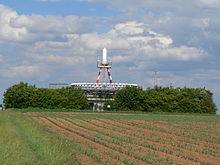Tactical Air Navigation


Tactical Air Navigation ( TACAN , TAC tical A ir N avigation system, English for tactical air navigation ) is a military radio beacon that the civil use VOR / DME is very similar. TACAN provides distance and azimuth information ( polar coordinates ) from a single ground station.
The TACAN and DME systems are interoperable, with the combinations TACAN on-board device / DME ground station, DME on-board device / TACAN ground station and DME on-board device / DME ground station only supplying distance information; only the combination of TACAN on-board unit / TACAN ground station provides both distance and azimuth information .
The device combination, consisting of the VOR and TACAN, is used in the Bundeswehr Air Force under the name VORTAC . Civil aircraft get azimuth information from the VOR part of the VORTAC and range information from the DME-compatible TACAN part; Military aircraft get azimuth and range information from the TACAN (without using the VOR). TACAN devices are also used on military ships to provide navigation, e.g. B. on-board helicopters back to the mother ship to allow in bad weather.
Working method
TACAN radio beacons operate in the NATO frequency range of 960–1215 MHz (divided into 126 X and Y channels each), which is assigned to the air navigation service for primary use. With the TACAN, the direction information is always related to magnetic north (see VOR rotary radio beacon ). The corresponding display instrument always shows the clockwise angle from north to the connecting line between the aircraft and the ground station.
While the direction information is available to any number of aircraft at the same time, only a maximum of 100 aircraft can be operated at the same time for distance measurement, whereby the 100 strongest signals always have priority. However, the distances supplied by TACAN are basically inclined distances, i.e. the direct distance between the aircraft and the ground station. The exact distance can only be determined if the height above ground or the elevation angle is known. The TACAN works with a quasi-optical view up to a distance of 390 nautical miles.
Unlike the VOR, a TACAN station can also be on board another military aircraft. B. used when approaching tanker aircraft. The aiming of other aircraft is less precise than to a ground station, since most aircraft can only send the 15 Hz sine, which results in an accuracy / error of 3 ° to 5 °. With a TACAN ground station, the 15 Hz sine is additionally modulated by 135 Hz amplitude modulation, so the 15 Hz is the rough information and the 135 Hz the fine information of the direction to the station related to magnetic north.
In addition, unlike the VOR, the main reference pulse (MRB) is only sent out when the beacon is pointing to the east, a secondary reference pulse (ARB) is sent every 40 degrees. The MRB is important for the system as it marks the starting point of the angle measurement for the next positive zero crossing of the 15 Hz oscillation. For example, with an MRB pulse at 180 ° to the next positive zero crossing of the 15 Hz sinusoidal oscillation (360 °) there is an angle of 180 °, so the station is facing south. With MRB 90 ° (neg.) = Angle 90 ° to the next pos. Zero crossing = station heading east With MRB 90 ° (pos.) = Angle 270 ° to the next pos. Zero crossing = station heading west With MRB 0 ° = angle 0 ° station heading north
Frequency availability
On the part of the frequency management , the frequency availability was declared with restrictions for TACAN . For example, air-based use in German airspace and use on ships in German territorial waters are not permitted.
TACAN stations in Europe
The frequency channels are coordinated and allocated for the relevant TACAN locations across Europe.
Denmark
| Station name | Identifier | channel | Coordinates | Station height |
|---|---|---|---|---|
| Karup TACAN | KAR | 037X | 56 ° 17'48 "N 09 ° 00'31" E |
Germany
| Station name | Identifier | channel | Coordinates | Station height |
|---|---|---|---|---|
| Geilenkirchen TACAN | GIX | 18X | 50 ° 57.8001'N 006 ° 02.7119'E | 327 ft MSL (100 meters) |
| Mockery of TACAN | HNT | 100X | 54 ° 18'39 "N 009 ° 32'19" E | |
| Wooden village TACAN | HOZ | 119Y | 51 ° 46.0030'N 013 ° 11.9375'E | 308 ft MSL (80 meters) |
| Ingolstadt TACAN | IGL | 51X | 48 ° 43.0824'N 011 ° 34.1803'E | 1237 ft MSL (376 meters) |
| Laage TACAN | LAG | 19Y | 53 ° 55.1915'N 012 ° 17.1851'E | 190 ft MSL (58 meters) |
| Landsberg TACAN | LAB | 58Y | 48 ° 03'54.95 "N 10 ° 52'50.883" E | |
| Lechfeld TACAN | LCH | 25X | 48 ° 11.4258'N 010 ° 51.5395'E | 1838 ft MSL (560 meters) |
| Neubrandenburg TACAN | NEG | 17Y | 53 ° 36.2764'N 013 ° 18.5191'E | 270 ft MSL (82 meters) |
| Neuburg TACAN | NEW | 26X | 48 ° 42.75'N 011 ° 12.66'E | 1296 ft MSL (395 meters) |
| Nörvenich VORTAC | NOR | 109X | 50 ° 50.4395'N 006 ° 41.6493'E | 367 ft MSL (112 meters) |
| Nordholz TACAN | NDO | 118X | 53 ° 46.1389'N 008 ° 39.2131'E | 120 ft MSL (37 meters) |
| Osnabrück TACAN | OSB | 20Y | 52 ° 12.0082'N 008 ° 17.1312'E | 417 ft MSL (127 meters) |
| Ramstein TACAN | RMS | 81X | 49 ° 26.0840'N 007 ° 35.1392'E | 805 ft MSL (245 meters) |
| Schleswig TACAN | SWG | 55X | 54 ° 27.2230'N 009 ° 30.0911'E | 105 ft MSL (32 meters) |
| Spangdahlem TACAN | SPA | 032X | 49 ° 58'44 "N 006 ° 41'52" E | |
| Tango TACAN | TGO | 72X | 48 ° 37.1045'N 009 ° 15.5526'E | 1246 ft MSL (380 meters) |
| Wittmund TACAN | WTM | 82X | 53 ° 33.2600'N 007 ° 43.5067'E | 61 ft MSL (19 meters) |
| Wunstorf TACAN | WUN | 95Y | 52 ° 27.2914'N 009 ° 25.7630'E |
Switzerland
There are no TACAN stations in Switzerland.
Austria
There are no TACAN stations in Austria.
Web links
Individual evidence
- ↑ Frequency availability for TACAN see NATO Joint Civil / Military Frequency Agreement (NJFA) frequency range 960–1215 MHz.
